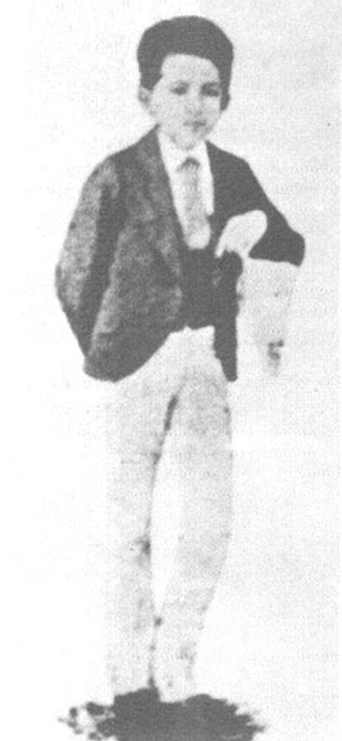José Protacio Rizal Mercado y Alonso Realonda (June 19, 1861 – December 30, 1896) was a Filipino nationalist, novelist, poet, ophthalmologist, journalist, and revolutionary. He is widely considered as one of the greatest heroes of the Philippines.[6] He was the author of Noli Me Tángere,[7] El Filibusterismo,[8] and a number of poems and essays. He was executed on December 30, 1896 by a squad of Filipino soldiers of the Spanish Army.[9][10]
Jose Rizal was born to the wealthy Mercado-Rizal family in Calamba,Laguna of the Philippines. The Mercado-Rizals were considered one of the most prestigious Filipino families during their time. Jose Rizal came from the 13-member family consisting of his parents, Francisco Mercado II and Teodora Alonso Realonda, and nine sisters and one brother. His parents were leaseholders of a hacienda and an accompanying rice farm by theDominicans.[11][12]
From an early age, Jose Rizal Mercado showed a precocious intellect. He learned the alphabet from his mother at 3, and could read and write at age 5.[12]Upon enrolling at the Ateneo Municipal de Manila, José dropped the last three names that make up his full name, on the advice of his brother, Paciano Rizal, and the Mercado-Rizal family, thus rendering his name as "José Protasio Rizal". Of this, Rizal writes: "My family never paid much attention [to our second surname Rizal], but now I had to use it, thus giving me the appearance of an illegitimate child!"[13] This was to enable him to travel freely and disassociate him from his brother, who had gained notoriety with his earlier links to Gomburza. From early childhood, José and Paciano were already advancing unheard-of political ideas of freedom and individual rights which infuriated the authorities.[note 1][note 2] Despite the name change, José, as "Rizal" soon distinguished himself in poetry writing contests, impressing his professors with his facility with Castilian and other foreign languages, and later, in writing essays that were critical of the Spanish historical accounts of the pre-colonial Philippine societies. Indeed, by 1891, the year he finished his El filibusterismo, this second surname had become so well known that, as he writes to another friend, "All my family now carry the name Rizal instead of Mercado because the name Rizal means persecution! Good! I too want to join them and be worthy of this family name...".
Education

Education
Rizal first studied under Justiniano Aquino Cruz in Biñan, Laguna before he was sent to Manila. As to his father's request, he took the entrance examination in Colegio de San Juan de Letran and studied there for almost three months. He then enrolled at theAteneo Municipal de Manila and graduated as one of the nine students in his class declared sobresaliente or outstanding. He continued his education at the Ateneo Municipal de Manila to obtain a land surveyor and assessor's degree, and at the same time at the University of Santo Tomas where he did take up a preparatory course in law.[15] Upon learning that his mother was going blind, he decided to switch to medicine at the medical school of Santo Tomas specializing later inophthalmology.
José Rizal as a student at the University of Santo Tomas
Without his parents' knowledge and consent, but secretly supported by his brother Paciano, he traveled alone toMadrid, Spain in May 1882 and studied medicine at the Universidad Central de Madrid where he earned the degree,Licentiate in Medicine. Also, he also attended medical lectures at theUniversity of Paris and the University of Heidelberg. In Berlin he was inducted as a member of the Berlin Ethnological Society and the Berlin Anthropological Society under the patronage of the famous pathologist Rudolf Virchow. Following custom, he delivered an address in German in April 1887 before the Anthropological Society on the orthography and structure of theTagalog language. He left Heidelberg a poem, "A las flores del Heidelberg", which was both an evocation and a prayer for the welfare of his native land and the unification of common values between East and West.
At Heidelberg, the 25-year-old Rizal, completed in 1887 his eye specialization under the renowned professor, Otto Becker. There he used the newly invented ophthalmoscope(invented by Hermann von Helmholtz) to later operate on his own mother's eye. From Heidelberg, Rizal wrote his parents: "I spend half of the day in the study of German and the other half, in the diseases of the eye. Twice a week, I go to the bierbrauerie, or beerhall, to speak German with my student friends." He lived in a Karlstraße boarding house then moved to Ludwigsplatz. There, he met Reverend Karl Ullmer and stayed with them in Wilhelmsfeld, where he wrote the last few chapters of Noli Me Tángere.
Rizal was a polymath, skilled in both science and the arts. He painted, sketched, and made sculptures and woodcarving. He was a prolific poet, essayist, and novelist whose most famous works were his two novels, Noli Me Tángere and its sequel, El filibusterismo.[note 3][7] These social commentaries during the Spanish colonization of the country formed the nucleus of literature that inspired peaceful reformists and armed revolutionaries alike. Rizal was also apolyglot, conversant in twenty-two languages.[note 4][note 5][16][17]
Rizal's multifacetedness was described by his German friend, Dr. Adolf Meyer, as "stupendous."[note 6] Documented studies show him to be a polymath with the ability to master various skills and subjects.[16][18][18][19] He was anophthalmologist, sculptor, painter, educator, farmer, historian, playwright and journalist. Besides poetry andcreative writing, he dabbled, with varying degrees of expertise, in architecture, cartography, economics,ethnology, anthropology, sociology,dramatics, martial arts, fencing andpistol shooting. He was also aFreemason, joining Acacia Lodge No. 9 during his time in Spain and becoming a Master Mason in 1884.




No comments:
Post a Comment